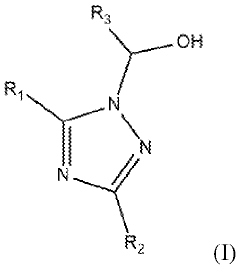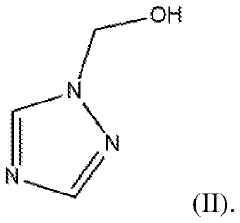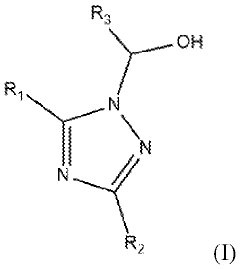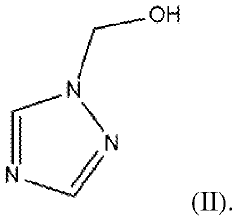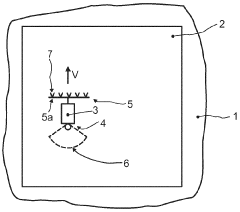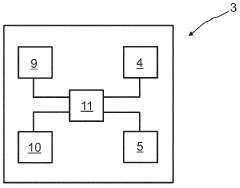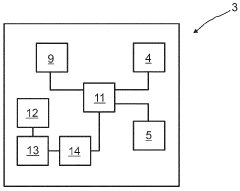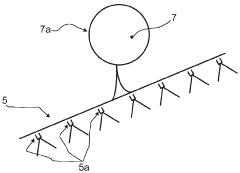Nitrification Responses To Fertilizer Inhibitor Applications
SEP 12, 20259 MIN READ
Generate Your Research Report Instantly with AI Agent
Patsnap Eureka helps you evaluate technical feasibility & market potential.
Nitrification Inhibitor Technology Background and Objectives
Nitrification inhibitors have emerged as a critical technology in modern agriculture, evolving significantly over the past several decades. These compounds were first conceptualized in the 1960s when researchers began recognizing the substantial nitrogen losses occurring in agricultural systems through nitrification processes. The technology aims to slow the biological oxidation of ammonium to nitrate by inhibiting the activity of nitrifying bacteria, particularly Nitrosomonas species, in soil environments.
The evolution of nitrification inhibitors has progressed through several generations of compounds. Early inhibitors such as nitrapyrin (N-Serve) and dicyandiamide (DCD) established the foundation of this technology in the 1970s and 1980s. These were followed by more sophisticated formulations including DMPP (3,4-dimethylpyrazole phosphate) and more recently, novel compounds like DMPSA (2-(N-3,4-dimethyl-1H-pyrazol-1-yl) succinic acid) and various pyrazole derivatives that offer enhanced efficacy and environmental compatibility.
The primary technological objective of nitrification inhibitors is to improve nitrogen use efficiency (NUE) in agricultural systems by maintaining nitrogen in the ammonium form for longer periods. This reduces losses through leaching and denitrification, which can account for up to 50% of applied nitrogen fertilizers in conventional systems. By extending the residence time of nitrogen in soil, these inhibitors aim to synchronize nitrogen availability with crop uptake patterns, thereby optimizing fertilizer investments.
Another critical objective is the mitigation of environmental impacts associated with nitrogen fertilization. Nitrification inhibitors seek to reduce nitrate leaching into groundwater and surface water bodies, which contributes to eutrophication and drinking water contamination. Additionally, they target the reduction of nitrous oxide (N₂O) emissions, a potent greenhouse gas with approximately 300 times the global warming potential of carbon dioxide, which is produced during both nitrification and subsequent denitrification processes.
The technology also aims to address the growing challenge of feeding an expanding global population while minimizing the environmental footprint of agriculture. With projections indicating the need for a 50% increase in food production by 2050, nitrification inhibitors represent a pathway to intensify production sustainably by enhancing the efficiency of existing agricultural inputs rather than simply increasing application rates.
Recent technological developments have focused on creating inhibitor formulations with greater stability across diverse soil conditions, temperatures, and moisture regimes. Research is also exploring synergistic combinations of different inhibitor compounds and developing controlled-release mechanisms to extend inhibitor activity periods, aligning with the trend toward precision agriculture and site-specific management strategies.
The evolution of nitrification inhibitors has progressed through several generations of compounds. Early inhibitors such as nitrapyrin (N-Serve) and dicyandiamide (DCD) established the foundation of this technology in the 1970s and 1980s. These were followed by more sophisticated formulations including DMPP (3,4-dimethylpyrazole phosphate) and more recently, novel compounds like DMPSA (2-(N-3,4-dimethyl-1H-pyrazol-1-yl) succinic acid) and various pyrazole derivatives that offer enhanced efficacy and environmental compatibility.
The primary technological objective of nitrification inhibitors is to improve nitrogen use efficiency (NUE) in agricultural systems by maintaining nitrogen in the ammonium form for longer periods. This reduces losses through leaching and denitrification, which can account for up to 50% of applied nitrogen fertilizers in conventional systems. By extending the residence time of nitrogen in soil, these inhibitors aim to synchronize nitrogen availability with crop uptake patterns, thereby optimizing fertilizer investments.
Another critical objective is the mitigation of environmental impacts associated with nitrogen fertilization. Nitrification inhibitors seek to reduce nitrate leaching into groundwater and surface water bodies, which contributes to eutrophication and drinking water contamination. Additionally, they target the reduction of nitrous oxide (N₂O) emissions, a potent greenhouse gas with approximately 300 times the global warming potential of carbon dioxide, which is produced during both nitrification and subsequent denitrification processes.
The technology also aims to address the growing challenge of feeding an expanding global population while minimizing the environmental footprint of agriculture. With projections indicating the need for a 50% increase in food production by 2050, nitrification inhibitors represent a pathway to intensify production sustainably by enhancing the efficiency of existing agricultural inputs rather than simply increasing application rates.
Recent technological developments have focused on creating inhibitor formulations with greater stability across diverse soil conditions, temperatures, and moisture regimes. Research is also exploring synergistic combinations of different inhibitor compounds and developing controlled-release mechanisms to extend inhibitor activity periods, aligning with the trend toward precision agriculture and site-specific management strategies.
Agricultural Market Demand Analysis for Fertilizer Efficiency
The global fertilizer market has witnessed significant shifts in demand patterns, driven by the increasing need for sustainable agricultural practices. With the world population projected to reach 9.7 billion by 2050, agricultural productivity must increase by approximately 70% to meet food demands. This has created substantial market opportunities for advanced fertilizer technologies, particularly nitrification inhibitors that improve nitrogen use efficiency.
Market research indicates that the global nitrification inhibitors market was valued at $2.9 billion in 2022 and is expected to grow at a compound annual growth rate of 8.2% through 2030. This growth is primarily fueled by increasing awareness of environmental concerns related to nitrogen leaching and greenhouse gas emissions from conventional fertilizer applications.
Regional analysis reveals varying adoption rates of fertilizer inhibitor technologies. North America and Europe lead the market due to stringent environmental regulations and higher awareness among farmers. The Asia-Pacific region, particularly China and India, represents the fastest-growing market segment, driven by government initiatives to promote sustainable farming practices and reduce environmental pollution from agricultural activities.
Consumer demand patterns show a clear preference shift toward environmentally friendly agricultural inputs. Surveys indicate that 67% of large-scale farmers in developed countries are willing to pay premium prices for fertilizers with proven efficiency-enhancing properties. This trend is gradually extending to medium and small-scale farmers as the economic benefits of reduced fertilizer waste become more apparent.
The economic value proposition of nitrification inhibitors is compelling. Field trials across various crops and regions demonstrate that proper application of these inhibitors can reduce nitrogen fertilizer requirements by 15-30% while maintaining or even improving crop yields. This translates to potential savings of $50-150 per hectare for farmers, depending on crop type and local fertilizer prices.
Market segmentation analysis reveals that row crops (corn, wheat, rice) account for approximately 65% of nitrification inhibitor applications, followed by specialty crops (20%) and pasture/forage systems (15%). The demand is particularly strong in intensive agricultural systems where nitrogen inputs are high and environmental concerns are prominent.
Distribution channels are evolving, with agricultural retailers and cooperatives playing a crucial role in product delivery and farmer education. Digital agriculture platforms are increasingly important in connecting farmers with advanced fertilizer solutions and providing decision support tools for optimal application timing and rates based on soil conditions and weather forecasts.
Market research indicates that the global nitrification inhibitors market was valued at $2.9 billion in 2022 and is expected to grow at a compound annual growth rate of 8.2% through 2030. This growth is primarily fueled by increasing awareness of environmental concerns related to nitrogen leaching and greenhouse gas emissions from conventional fertilizer applications.
Regional analysis reveals varying adoption rates of fertilizer inhibitor technologies. North America and Europe lead the market due to stringent environmental regulations and higher awareness among farmers. The Asia-Pacific region, particularly China and India, represents the fastest-growing market segment, driven by government initiatives to promote sustainable farming practices and reduce environmental pollution from agricultural activities.
Consumer demand patterns show a clear preference shift toward environmentally friendly agricultural inputs. Surveys indicate that 67% of large-scale farmers in developed countries are willing to pay premium prices for fertilizers with proven efficiency-enhancing properties. This trend is gradually extending to medium and small-scale farmers as the economic benefits of reduced fertilizer waste become more apparent.
The economic value proposition of nitrification inhibitors is compelling. Field trials across various crops and regions demonstrate that proper application of these inhibitors can reduce nitrogen fertilizer requirements by 15-30% while maintaining or even improving crop yields. This translates to potential savings of $50-150 per hectare for farmers, depending on crop type and local fertilizer prices.
Market segmentation analysis reveals that row crops (corn, wheat, rice) account for approximately 65% of nitrification inhibitor applications, followed by specialty crops (20%) and pasture/forage systems (15%). The demand is particularly strong in intensive agricultural systems where nitrogen inputs are high and environmental concerns are prominent.
Distribution channels are evolving, with agricultural retailers and cooperatives playing a crucial role in product delivery and farmer education. Digital agriculture platforms are increasingly important in connecting farmers with advanced fertilizer solutions and providing decision support tools for optimal application timing and rates based on soil conditions and weather forecasts.
Current Challenges in Nitrification Inhibitor Development
Despite significant advancements in nitrification inhibitor technology, several critical challenges continue to impede the development of optimal solutions for agricultural applications. One primary obstacle is the inconsistent performance of current inhibitors across diverse soil types, climate conditions, and cropping systems. Field trials frequently demonstrate variable efficacy rates ranging from 5% to 70% depending on environmental factors, creating uncertainty for farmers and limiting widespread adoption.
The persistence and stability of nitrification inhibitors present another significant challenge. Many current formulations degrade rapidly under high temperatures or in alkaline soils, substantially reducing their effective period. For instance, dicyandiamide (DCD) can lose up to 50% of its efficacy within 10-14 days in temperatures exceeding 20°C, necessitating multiple applications that increase both cost and environmental footprint.
Regulatory hurdles and environmental concerns further complicate inhibitor development. Stringent approval processes for new agricultural chemicals can take 8-10 years and cost upwards of $250 million, discouraging innovation in this space. Additionally, emerging evidence suggests some inhibitors may contribute to non-target effects on beneficial soil microorganisms or potentially leach into water systems, raising ecological concerns that must be addressed.
Cost-effectiveness remains a substantial barrier to widespread adoption. Current nitrification inhibitors add approximately $15-30 per hectare to fertilizer costs, representing a 10-20% premium that many farmers find difficult to justify without guaranteed yield improvements or environmental incentives. This economic challenge is particularly acute in developing regions where profit margins are already constrained.
Formulation challenges also persist, particularly in creating stable mixtures that can be effectively incorporated with different fertilizer types. Compatibility issues between inhibitors and certain fertilizer compounds can reduce shelf life and application efficiency, while uneven distribution in granular formulations leads to inconsistent field performance.
The molecular specificity of current inhibitors presents another limitation. Most commercial products target only ammonia monooxygenase enzymes in ammonia-oxidizing bacteria, while neglecting other nitrification pathways such as those in ammonia-oxidizing archaea, which can dominate in certain agricultural ecosystems and contribute significantly to nitrogen transformation processes.
Finally, there is insufficient standardization in testing protocols and performance metrics across the industry, making it difficult to compare different products objectively and establish reliable best practices for their application in various agricultural contexts.
The persistence and stability of nitrification inhibitors present another significant challenge. Many current formulations degrade rapidly under high temperatures or in alkaline soils, substantially reducing their effective period. For instance, dicyandiamide (DCD) can lose up to 50% of its efficacy within 10-14 days in temperatures exceeding 20°C, necessitating multiple applications that increase both cost and environmental footprint.
Regulatory hurdles and environmental concerns further complicate inhibitor development. Stringent approval processes for new agricultural chemicals can take 8-10 years and cost upwards of $250 million, discouraging innovation in this space. Additionally, emerging evidence suggests some inhibitors may contribute to non-target effects on beneficial soil microorganisms or potentially leach into water systems, raising ecological concerns that must be addressed.
Cost-effectiveness remains a substantial barrier to widespread adoption. Current nitrification inhibitors add approximately $15-30 per hectare to fertilizer costs, representing a 10-20% premium that many farmers find difficult to justify without guaranteed yield improvements or environmental incentives. This economic challenge is particularly acute in developing regions where profit margins are already constrained.
Formulation challenges also persist, particularly in creating stable mixtures that can be effectively incorporated with different fertilizer types. Compatibility issues between inhibitors and certain fertilizer compounds can reduce shelf life and application efficiency, while uneven distribution in granular formulations leads to inconsistent field performance.
The molecular specificity of current inhibitors presents another limitation. Most commercial products target only ammonia monooxygenase enzymes in ammonia-oxidizing bacteria, while neglecting other nitrification pathways such as those in ammonia-oxidizing archaea, which can dominate in certain agricultural ecosystems and contribute significantly to nitrogen transformation processes.
Finally, there is insufficient standardization in testing protocols and performance metrics across the industry, making it difficult to compare different products objectively and establish reliable best practices for their application in various agricultural contexts.
Current Nitrification Control Methodologies
01 Nitrification inhibitors based on pyrazole derivatives
Pyrazole derivatives have been developed as effective nitrification inhibitors for fertilizers. These compounds work by inhibiting the activity of ammonia-oxidizing bacteria in soil, thereby slowing the conversion of ammonium to nitrate. This inhibition helps to reduce nitrogen losses through leaching and denitrification, improving nitrogen use efficiency in agricultural systems. The pyrazole-based inhibitors can be formulated with various fertilizers to create slow-release nitrogen products.- Nitrification inhibitors based on pyrazole derivatives: Pyrazole derivatives have been developed as effective nitrification inhibitors for fertilizers. These compounds work by inhibiting the activity of ammonia-oxidizing bacteria in soil, thereby slowing the conversion of ammonium to nitrate. This inhibition helps to reduce nitrogen losses through leaching and denitrification, improving nitrogen use efficiency in agricultural systems. The pyrazole-based inhibitors can be formulated with various fertilizers to create slow-release nitrogen products.
- Urease inhibitors combined with nitrification inhibitors: Fertilizer formulations that combine urease inhibitors with nitrification inhibitors provide dual protection against nitrogen losses. Urease inhibitors slow the hydrolysis of urea to ammonia, while nitrification inhibitors prevent the oxidation of ammonium to nitrate. This combination approach helps to maintain nitrogen in forms that are less susceptible to volatilization, leaching, and denitrification. These formulations are particularly effective in improving nitrogen use efficiency in agricultural systems with varying soil and environmental conditions.
- Novel stabilized nitrogen fertilizer compositions: Innovative stabilized nitrogen fertilizer compositions have been developed that incorporate nitrification inhibitors with specific carrier materials or delivery systems. These compositions are designed to provide controlled release of the inhibitors, extending their effectiveness in soil. The stabilized formulations may include polymeric coatings, microencapsulation techniques, or specific adjuvants that protect the inhibitors from degradation and optimize their distribution in the soil environment. These technologies help to maintain higher levels of plant-available nitrogen throughout the growing season.
- Natural and biological nitrification inhibitors: Research has focused on developing natural and biological alternatives to synthetic nitrification inhibitors. These include plant-derived compounds, microbial extracts, and other biological substances that can inhibit nitrification processes in soil. Natural inhibitors offer potential environmental benefits compared to synthetic chemicals and may be preferred for organic farming systems. These biological approaches work by interfering with the enzymatic pathways of nitrifying bacteria or by creating soil conditions that are less favorable for nitrification.
- Application methods and timing for nitrification inhibitors: Various application methods and timing strategies have been developed to optimize the effectiveness of nitrification inhibitors. These include precision application technologies, incorporation techniques, and timing recommendations based on soil temperature, moisture conditions, and crop growth stages. Proper application methods ensure that inhibitors remain active during critical periods of potential nitrogen loss. Research has shown that the effectiveness of nitrification inhibitors can be significantly influenced by application timing relative to environmental conditions and fertilizer placement.
02 Triazole compounds as nitrification inhibitors
Triazole compounds have been identified as effective nitrification inhibitors that can be incorporated into fertilizer formulations. These compounds inhibit the nitrification process by targeting specific enzymes involved in the conversion of ammonium to nitrite. By slowing this conversion, triazole-based inhibitors help to maintain nitrogen in the ammonium form for longer periods, reducing losses and improving plant uptake. These inhibitors can be applied with various nitrogen fertilizers to enhance their efficiency.Expand Specific Solutions03 Polymer-coated nitrification inhibitors for controlled release
Polymer coating technologies have been developed to encapsulate nitrification inhibitors, providing controlled release properties. These coatings protect the inhibitor from rapid degradation and allow for sustained release over time, extending the period of nitrification inhibition. The polymer-coated formulations can be designed with different release rates based on soil conditions, temperature, and moisture levels. This approach improves the efficiency of nitrification inhibitors and reduces the frequency of application needed.Expand Specific Solutions04 Combination of urease and nitrification inhibitors
Fertilizer formulations that combine both urease inhibitors and nitrification inhibitors have been developed to provide comprehensive nitrogen loss prevention. While nitrification inhibitors slow the conversion of ammonium to nitrate, urease inhibitors delay the hydrolysis of urea to ammonium. This dual-inhibition approach addresses multiple pathways of nitrogen loss, significantly improving nitrogen use efficiency. These combination products are particularly effective with urea-based fertilizers and can be formulated as granules, liquids, or coatings.Expand Specific Solutions05 Natural and biological nitrification inhibitors
Natural compounds and biological agents have been identified as environmentally friendly alternatives to synthetic nitrification inhibitors. These include plant-derived compounds, microbial extracts, and specific microorganisms that can suppress nitrifying bacteria. Natural inhibitors often work through multiple mechanisms and may provide additional benefits such as improved soil health. These bio-based inhibitors can be incorporated into organic fertilizer systems and are particularly valuable for sustainable and organic farming practices.Expand Specific Solutions
Key Industry Players in Agricultural Chemical Sector
The nitrification inhibitor market is currently in a growth phase, driven by increasing agricultural intensification and environmental regulations. The global market size is estimated to exceed $2 billion, with projected annual growth of 8-10%. Leading players include established agrochemical giants like BASF Corp. and Corteva Agriscience, who leverage extensive R&D capabilities to develop advanced inhibitor formulations. Specialized companies such as Koch Agronomic Services and Verdesian Life Sciences focus on innovative delivery systems and enhanced efficiency fertilizers. Technical maturity varies, with BASF and SABIC offering commercially proven products, while research institutions like Zhejiang University and the Institute of Soil Science (Chinese Academy of Sciences) are advancing next-generation inhibitors with improved environmental profiles and application specificity.
BASF Corp.
Technical Solution: BASF has developed advanced nitrification inhibitor technologies including their flagship products DMPP (3,4-dimethylpyrazole phosphate) marketed as Vizura® and LIMUS®. Their approach focuses on stabilizing nitrogen in ammonium form by specifically targeting nitrifying bacteria Nitrosomonas. BASF's inhibitors work by blocking the ammonia monooxygenase enzyme pathway, effectively delaying the conversion of ammonium to nitrate for 4-10 weeks depending on soil conditions. Their formulations have been engineered to work across diverse soil types and environmental conditions, with demonstrated nitrogen loss reduction of 30-50% in field trials. BASF has also developed specialized coating technologies that improve the controlled release properties of their inhibitors, ensuring optimal timing of nitrogen availability to crops while minimizing environmental losses.
Strengths: Global research capabilities with extensive field testing across diverse agricultural regions; comprehensive product portfolio addressing different fertilizer types; strong formulation expertise enabling stability across varying soil conditions. Weaknesses: Higher cost compared to conventional fertilizers; performance variability under extreme weather conditions; requires precise application timing for maximum effectiveness.
Tessenderlo Group NV
Technical Solution: Tessenderlo Group, through its NovaSource and Crop Vitality business units, has developed innovative approaches to nitrification management including thiosulfate-based technologies (Thio-Sul®) that function as both nutrient sources and nitrification regulators. Their technology works through a dual mechanism: providing sulfur nutrition while temporarily suppressing nitrifying bacteria activity through the release of tetrathionate intermediates. Field research demonstrates their products can improve nitrogen use efficiency by 15-25% across various crop systems. Tessenderlo's formulations are specifically designed to be compatible with liquid fertilizer systems and irrigation equipment, allowing for precise placement and timing. Their technology is particularly effective in calcareous soils where traditional inhibitors may have reduced efficacy. The company has also developed specialized blending systems that ensure uniform distribution of their products when combined with other liquid fertilizers.
Strengths: Dual-purpose technology providing both nutrient value and nitrification control; excellent compatibility with irrigation systems; particularly effective in high-pH soils where other inhibitors struggle. Weaknesses: Less persistent than some dedicated nitrification inhibitors; requires more precise application timing; efficacy more dependent on soil temperature conditions.
Critical Patents and Research in Inhibitor Mechanisms
Triazole methanol as nitrification inhibitor for fertilizer application
PatentWO2024033872A1
Innovation
- A triazole methanol compound is synthesized as a nitrification inhibitor, which can be formulated with melted urea and has a high melting point, providing stability and effectiveness across different soil types and temperature ranges, and is applied in combination with nitrogenous fertilizers and other inhibitors to reduce ammonia conversion to nitrate.
Method and vehicle for applying an agrochemical mixture to a working area of a field
PatentActiveZA202002634A
Innovation
- A method involving a vehicle-mounted system to separately apply solid fertilizers and liquid fertilizer additives, allowing for precise control of their ratio and timing to minimize nitrogen losses, using a solid fertilizer spreading device and a field sprayer configured to prevent contact and maintain even distribution, with optional use of nitrification, urease, or denitrification inhibitors to optimize fertilizer efficiency.
Environmental Impact Assessment of Inhibitor Applications
The application of nitrification inhibitors in agricultural systems presents significant environmental implications that warrant comprehensive assessment. These chemical compounds, designed to slow the conversion of ammonium to nitrate in soil, can substantially reduce nitrogen losses through leaching and gaseous emissions. Studies across various agricultural ecosystems indicate that properly applied inhibitors can decrease nitrate leaching by 15-30% and nitrous oxide emissions by 30-50%, contributing meaningfully to water quality protection and greenhouse gas mitigation efforts.
Environmental monitoring of inhibitor applications reveals complex interactions with soil microbial communities. While these compounds specifically target nitrifying bacteria like Nitrosomonas, research indicates minimal long-term disruption to overall soil microbial diversity and function when applied at recommended rates. However, repeated applications in sensitive ecosystems may alter microbial community structures, necessitating site-specific assessment protocols.
Watershed-level analyses demonstrate that widespread adoption of nitrification inhibitors could significantly reduce nitrogen loading in surface and groundwater systems. Models from the Mississippi River Basin suggest potential reductions of 10-15% in nitrogen export to the Gulf of Mexico if inhibitor use were implemented across 50% of suitable cropland, potentially mitigating hypoxic zone formation.
Climate impact assessments reveal dual benefits through reduced nitrous oxide emissions and improved nitrogen use efficiency. Life cycle analyses indicate that the carbon footprint associated with inhibitor manufacturing is substantially offset by emissions reductions in treated fields, with net greenhouse gas reductions of 1.2-3.5 tons CO₂-equivalent per hectare annually in intensive cropping systems.
Ecotoxicological studies present mixed findings regarding non-target effects. While most inhibitors demonstrate minimal acute toxicity to soil fauna and aquatic organisms at field application rates, certain compounds show potential for bioaccumulation in soil organisms. Dicyandiamide (DCD) residues have been detected in milk products in isolated cases, highlighting the importance of appropriate application timing and rates.
Regulatory frameworks for inhibitor assessment vary globally, with the European Union implementing the most comprehensive evaluation requirements through the REACH regulation. The United States EPA currently evaluates these compounds primarily through their pesticide regulatory framework, though specialized protocols for nitrification inhibitors are under development to better address their unique environmental behavior and impact pathways.
Future environmental assessment approaches must integrate advanced monitoring technologies, including sensor networks and remote sensing, to provide real-time feedback on inhibitor performance across diverse agricultural landscapes and climatic conditions, enabling precision application strategies that maximize environmental benefits while minimizing unintended consequences.
Environmental monitoring of inhibitor applications reveals complex interactions with soil microbial communities. While these compounds specifically target nitrifying bacteria like Nitrosomonas, research indicates minimal long-term disruption to overall soil microbial diversity and function when applied at recommended rates. However, repeated applications in sensitive ecosystems may alter microbial community structures, necessitating site-specific assessment protocols.
Watershed-level analyses demonstrate that widespread adoption of nitrification inhibitors could significantly reduce nitrogen loading in surface and groundwater systems. Models from the Mississippi River Basin suggest potential reductions of 10-15% in nitrogen export to the Gulf of Mexico if inhibitor use were implemented across 50% of suitable cropland, potentially mitigating hypoxic zone formation.
Climate impact assessments reveal dual benefits through reduced nitrous oxide emissions and improved nitrogen use efficiency. Life cycle analyses indicate that the carbon footprint associated with inhibitor manufacturing is substantially offset by emissions reductions in treated fields, with net greenhouse gas reductions of 1.2-3.5 tons CO₂-equivalent per hectare annually in intensive cropping systems.
Ecotoxicological studies present mixed findings regarding non-target effects. While most inhibitors demonstrate minimal acute toxicity to soil fauna and aquatic organisms at field application rates, certain compounds show potential for bioaccumulation in soil organisms. Dicyandiamide (DCD) residues have been detected in milk products in isolated cases, highlighting the importance of appropriate application timing and rates.
Regulatory frameworks for inhibitor assessment vary globally, with the European Union implementing the most comprehensive evaluation requirements through the REACH regulation. The United States EPA currently evaluates these compounds primarily through their pesticide regulatory framework, though specialized protocols for nitrification inhibitors are under development to better address their unique environmental behavior and impact pathways.
Future environmental assessment approaches must integrate advanced monitoring technologies, including sensor networks and remote sensing, to provide real-time feedback on inhibitor performance across diverse agricultural landscapes and climatic conditions, enabling precision application strategies that maximize environmental benefits while minimizing unintended consequences.
Regulatory Framework for Agricultural Chemical Innovations
The regulatory landscape governing fertilizer inhibitors and nitrification control technologies has evolved significantly over the past decade, creating a complex framework that agricultural chemical innovators must navigate. At the international level, organizations such as the Food and Agriculture Organization (FAO) and the International Fertilizer Association (IFA) have established guidelines for sustainable fertilizer use, including recommendations for nitrification inhibitors as tools to reduce environmental impacts.
In the United States, fertilizer inhibitors fall under the regulatory purview of multiple agencies. The Environmental Protection Agency (EPA) regulates these products under the Federal Insecticide, Fungicide, and Rodenticide Act (FIFRA), requiring extensive safety and efficacy data before market approval. The FDA may also become involved when considering potential impacts on food crops, while the USDA provides guidance on best management practices incorporating these technologies.
The European Union has implemented one of the most stringent regulatory frameworks through the Registration, Evaluation, Authorization and Restriction of Chemicals (REACH) regulation and the Nitrates Directive. These regulations specifically address nitrogen management and have accelerated the development of advanced nitrification inhibitors that meet strict environmental standards.
China and India, as major agricultural producers and fertilizer consumers, have recently strengthened their regulatory approaches. China's Ministry of Agriculture has introduced policies promoting "green" fertilizers, including those with inhibitor technologies, as part of its national strategy to reduce fertilizer use while maintaining crop yields.
Regulatory approval processes typically require manufacturers to demonstrate both efficacy in controlling nitrification processes and safety profiles regarding soil health, water quality, and non-target organisms. The timeline for approval varies significantly by region, ranging from 2-3 years in some Asian markets to 5-7 years in the EU and North America.
Recent regulatory trends indicate a shift toward lifecycle assessment approaches, where inhibitors are evaluated not only for their immediate impacts but also for their long-term effects on soil microbial communities and ecosystem services. This has prompted innovation in formulation technologies that enhance biodegradability while maintaining field performance.
Harmonization efforts between regulatory bodies are emerging, particularly regarding testing protocols and safety standards. The Global Alliance for Climate-Smart Agriculture has been instrumental in facilitating dialogue between regulatory agencies to streamline approval processes for technologies that demonstrate clear environmental benefits through reduced nitrous oxide emissions.
In the United States, fertilizer inhibitors fall under the regulatory purview of multiple agencies. The Environmental Protection Agency (EPA) regulates these products under the Federal Insecticide, Fungicide, and Rodenticide Act (FIFRA), requiring extensive safety and efficacy data before market approval. The FDA may also become involved when considering potential impacts on food crops, while the USDA provides guidance on best management practices incorporating these technologies.
The European Union has implemented one of the most stringent regulatory frameworks through the Registration, Evaluation, Authorization and Restriction of Chemicals (REACH) regulation and the Nitrates Directive. These regulations specifically address nitrogen management and have accelerated the development of advanced nitrification inhibitors that meet strict environmental standards.
China and India, as major agricultural producers and fertilizer consumers, have recently strengthened their regulatory approaches. China's Ministry of Agriculture has introduced policies promoting "green" fertilizers, including those with inhibitor technologies, as part of its national strategy to reduce fertilizer use while maintaining crop yields.
Regulatory approval processes typically require manufacturers to demonstrate both efficacy in controlling nitrification processes and safety profiles regarding soil health, water quality, and non-target organisms. The timeline for approval varies significantly by region, ranging from 2-3 years in some Asian markets to 5-7 years in the EU and North America.
Recent regulatory trends indicate a shift toward lifecycle assessment approaches, where inhibitors are evaluated not only for their immediate impacts but also for their long-term effects on soil microbial communities and ecosystem services. This has prompted innovation in formulation technologies that enhance biodegradability while maintaining field performance.
Harmonization efforts between regulatory bodies are emerging, particularly regarding testing protocols and safety standards. The Global Alliance for Climate-Smart Agriculture has been instrumental in facilitating dialogue between regulatory agencies to streamline approval processes for technologies that demonstrate clear environmental benefits through reduced nitrous oxide emissions.
Unlock deeper insights with Patsnap Eureka Quick Research — get a full tech report to explore trends and direct your research. Try now!
Generate Your Research Report Instantly with AI Agent
Supercharge your innovation with Patsnap Eureka AI Agent Platform!
